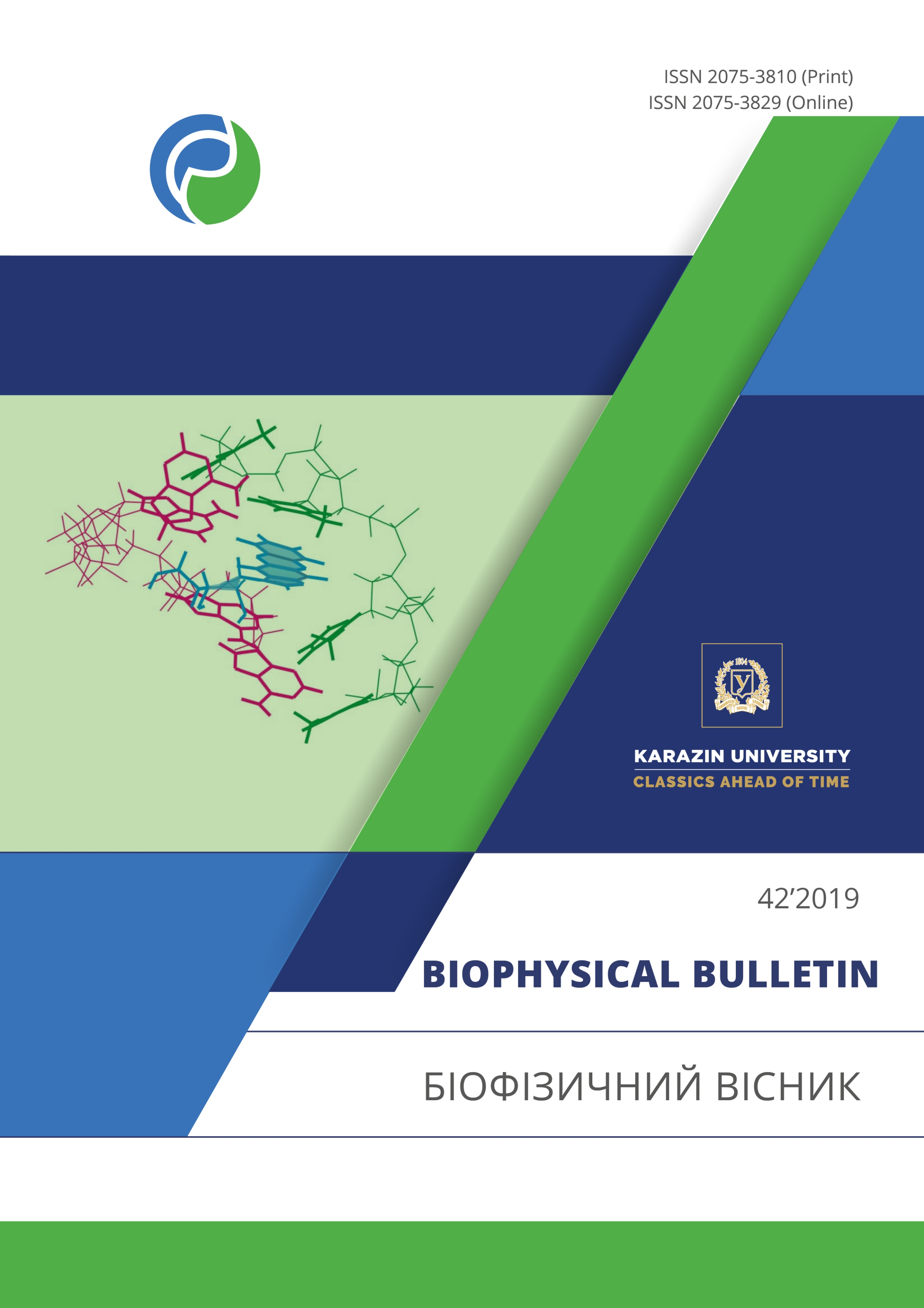Вплив адсорбції лігандів на вихідний сигнал ДНК-біосенсора
Анотація
Актуальність. Важлива перевага застосування ДНК-біосенсорів в порівнянні з традиційними молекулярно-біологічними методами пов'язана з мініатюризацією досліджуваних зразків і аналізаторів, що значно знижує вартість аналізу і час його проведення. Однак мініатюризація неминуче призводить як до зменшення величини вихідного сигналу ДНК-біосенсора, так і до підвищення рівня шумів сигналу. Тому стають актуальними дослідження, присвячені впливу різних чинників, зокрема лігандів, на величину вихідного сигналу ДНК-біосенсорів і рівень шумів.
Мета роботи. Теоретично розрахувати залежність вихідного сигналу ДНК-біосенсора від концентрації лігандів у розчині. Дослідити характерні особливості вихідного сигналу ДНК-біосенсора.
Теорія. Модель, в рамках якої проводяться теоретичні розрахунки, наступна. Є підложка, на якій іммобілізовані одноланцюгові молекули ДНК-мішеней. Підложка межує з розчином, де є як комплементарні з ДНК-мішенню одноланцюгові ДНК, так і ліганди, здатні адсорбуватися на дуплекси ДНК. Величина вихідного сигналу ДНК-біосенсора пропорційна числу дуплексів ДНК. Адсорбція лігандів на дуплекси ДНК призводить до зміни вихідного сигналу ДНК-біосенсора. Приймаємо, що адсорбований ліганд збільшує вихідний сигнал ДНК-біосенсора. Оскільки утворення і розпад комплексу лігандів з дуплексом ДНК відбувається випадковим чином, то число пов'язаних з дуплексом ДНК лігандів буде змінюватись випадковим чином, що неминуче приведе до флуктуації вихідного сигналу ДНК-біосенсора.
Результати. Показано, що зі збільшенням концентрації лігандів в розчині вихідний сигнал ДНК-біосенсорів монотонно зростає, а час релаксації вихідного сигналу зменшується. Показано також, що дисперсія вихідного сигналу ДНК-біосенсора зі збільшенням концентрації лігандів в розчині спочатку збільшується, а потім, проходячи через максимум, зменшується і прямує до нуля при подальшому збільшенні концентрації лігандів в розчині.
Висновки. Отримані дані можуть бути використані на практиці при виготовленні мікро ДНК-біосенсорів і аналізі результатів вимірювань.
Завантаження
Посилання
Mullen, W.H., & Evans, G.P. (1988). Biosensors in laboratory. Int. Labmate, 13, 15-17.
Turner, E., Carube, I., & Wilson, J. (1992). Biosensory, osnovy i prilozhenija. Moskow: Mir. (In Russian).
Drummond, T.G., Hill, M.G., & Barton, J. (2003). Electrochemical DNA sensors. Nat. biotechnol., 21(10), 1192-1199.
Domany, E. (2005). Analysis of DNA-chip and antigen-chip data: studies of cancer, stem cells and autoimmune diseases. Comp. Phys. Commun., 169, 183-187.
Yevdokimov, Y.M. (1998). Biosenors Based on Single-and Double-Stranded Linear DNA Molecules. Sensory systems, 12(1), 1-13.
Vardevanyan, P.O., Antonyan, A.P., Parsadanyan, M.A., Shahinyan, M.A., & Melkonyan, G.A. (2015). Behavior of ethidium bromide-Hoechst 33258-DNA and ethidium bromide-methylene blue-DNA triple systems by means of UV melting. International Journal of Spectroscopy, 2015, 1-5. doi: 10.1155/2015/586231.
Karapetian, A.T., Grigoryan, Z.A., Mаmasakhlisov, Y.S., Minasyants, M.V., & Vardevanyan, P.O. (2016). Theoretical treatment of helix-coil transition of complexes DNA with two different ligands having different binding parameters. J. Biomol. Struct. Dyn., 34(1), 201-205.
Vardevanyan, P.O., Antonyan, A.P., Parsadanyan, M.A., Torosyan, M.A., & Karapetian, A.T. (2016). Joint interaction of ethidium bromide and methylene blue with DNA. The effect of ionic strength on binding thermodynamic parameters. J. Biomol. Struct. Dyn., 34(7), 1377-1382.
Vardevanyan, P.O., Antonyan, A.P., Parsadanyan, M.A., Shahinyan, M.A., & Sahakyan, V.G. (2017). Peculiarities of interaction of synthetic polyribonucleotide poly(rA)-poly(rU) with some intercalators. J. Biomol. Struct. Dyn., 36(14), 3607-3613. doi: 10.1080/07391102.2017.1402708
Mamasakhlisov, Y., Sngryan, H., Tonoyan, Sh., Hakobyan, A., & Vardevanyan, P. (2018). The double-stranded DNA stability in presence of a flexible polymer. J. Biomol. Struct. Dyn., Published online: 23 Apr 2018. DOI: 10.1080/07391102.2018.1459320.
Tonoyan, Sh.A., Hakobyan, A.A., Andreassian, A.K., Morozov, V.F., & Mamasakhlisov, Y.Sh. (2018). Sensitivity of DNA sensors in the presence of charged ligands. Journal of Contemporary Physics, 53(2), 179-186.
Evtjugin, G.A., Budnikov, G.K., Porfir'eva, A.V. (2008). Jelektrohimicheskie DNK-sensory dlja opredelenija biologicheski aktivnyh nizkomolekuljarnyh soedinenij. Rossijskij himicheskij zhurnal (Zhurnal rossijskogo himicheskogo obshhestva im. D.I. Mendeleeva), LII(2), 66-79. (In Russian)
Cai, H., Cao, X., Jiang, Y., He, P., & Fang Y. (2003). Carbon nanotube-ehanced electrochemical DNA biosensor for DNA hybridization detection. Anal. Bioanal. Chem., 375(2), 287-235.
R. Kubo. (1967). Statisticheskaja mehanika. M.: Mir. (In Russian)
Arakelyan, V., Babayan, Yu., & Potikyan, G. (2000). Determination of constant rates of adsorption of ligand on DNA by analysis of correlation functions. J. Biomol. Struct. Dyn., 18(2), 231-235.
Arakelyan, V.B., Babayan, S.Yu., Tairyan, V.I., Arakelyan, A.V., Parsadanyan, M.A., & Vardevanyan, P.O. (2006). Kinetics of Ligand Binding to Nucleic Acids. J. Biomol. Struct. Dyn., 23(4), 479-483.
Автори, які публікуються у цьому журналі, погоджуються з наступними умовами:
- Автори залишають за собою право на авторство своєї роботи та передають журналу право першої публікації цієї роботи на умовах ліцензії Creative Commons Attribution License, котра дозволяє іншим особам вільно розповсюджувати опубліковану роботу з обов'язковим посиланням на авторів оригінальної роботи та першу публікацію роботи у цьому журналі.
- Автори мають право укладати самостійні додаткові угоди щодо неексклюзивного розповсюдження роботи у тому вигляді, в якому вона була опублікована цим журналом (наприклад, розміщувати роботу в електронному сховищі установи або публікувати у складі монографії), за умови збереження посилання на першу публікацію роботи у цьому журналі.
- Політика журналу дозволяє і заохочує розміщення авторами в мережі Інтернет (наприклад, у сховищах установ або на особистих веб-сайтах) рукопису роботи, як до подання цього рукопису до редакції, так і під час його редакційного опрацювання, оскільки це сприяє виникненню продуктивної наукової дискусії та позитивно позначається на оперативності та динаміці цитування опублікованої роботи (див. The Effect of Open Access).





